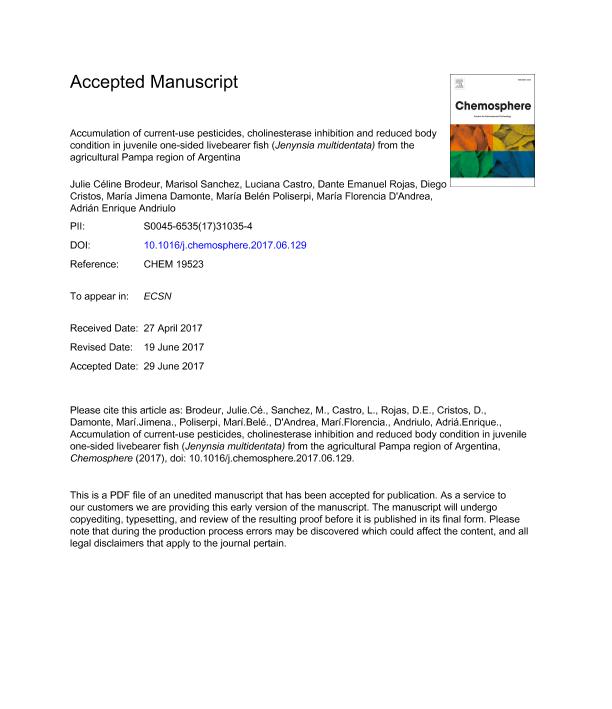Mostrar el registro sencillo del ítem
dc.contributor.author
Brodeur, Celine Marie Julie

dc.contributor.author
Sanchez, Marisol

dc.contributor.author
Castro, Luciana
dc.contributor.author
Rojas, Dante Emanuel

dc.contributor.author
Cristos, Diego Sebastián

dc.contributor.author
Damonte, Maria Jimena

dc.contributor.author
Poliserpi, Maria Belen

dc.contributor.author
D'andrea, María Florencia

dc.contributor.author
Andriulo, Adrian Enrique

dc.date.available
2018-04-05T16:01:56Z
dc.date.issued
2017-06
dc.identifier.citation
Brodeur, Celine Marie Julie; Sanchez, Marisol; Castro, Luciana; Rojas, Dante Emanuel; Cristos, Diego Sebastián; et al.; Accumulation of current-use pesticides, cholinesterase inhibition and reduced body condition in juvenile one-sided livebearer fish (Jenynsia multidentata) from the agricultural Pampa region of Argentina; Pergamon-Elsevier Science Ltd; Chemosphere; 185; 6-2017; 36-46
dc.identifier.issn
0045-6535
dc.identifier.uri
http://hdl.handle.net/11336/40880
dc.description.abstract
The aim of this study was to characterize the level and nature of the pesticide contamination received by one-sided livebearer fish (Jenynsia multidentata) from a watercourse situated within the main agricultural region of Argentina, and to assess the effects of this contamination on fish health. Juvenile one-sided livebearer fish (Jenynsia multidentata) were collected in December 2011 and March 2012 from three sites along the Pergamino River. Pesticide contamination was characterized by extracting whole fish and analytically determining thirty different pesticide molecules. The biomarkers catalase, glutathion-S-transferase, and cholinesterases were assessed. Body condition was calculated as an estimate of the amount of energy reserves possessed by the fish. Seventeen different pesticides were detected in fish tissues with 81% of captured animals containing at least one pesticide molecule. The pyrethroid insecticides fenvalerate and bifenthrin were most frequently detected, being respectively found in 41.8 and 36.4% of samples tested. Highly toxic dichlorvos and pirimiphos-methyl were detected. Differential levels of contamination could not be established amongst sites but were observed within sites amongst the two sampling dates. The months when pesticide residues were most abundant from Site A and B corresponded to the months when body condition was at its lowest in the two sites. The inibition of Che activity in March when body condition was reduced also points to a role of insecticide contamination in the reduction of body condition. These findings provide strong new evidence that current-used agricultural pesticides can accumulate in wild fish and impact their health and energetics.
dc.format
application/pdf
dc.language.iso
eng
dc.publisher
Pergamon-Elsevier Science Ltd

dc.rights
info:eu-repo/semantics/openAccess
dc.rights.uri
https://creativecommons.org/licenses/by-nc-nd/2.5/ar/
dc.subject
Insecticida
dc.subject
Plaguicida
dc.subject
Pez
dc.subject
Contaminacion
dc.subject.classification
Otras Ciencias Biológicas

dc.subject.classification
Ciencias Biológicas

dc.subject.classification
CIENCIAS NATURALES Y EXACTAS

dc.title
Accumulation of current-use pesticides, cholinesterase inhibition and reduced body condition in juvenile one-sided livebearer fish (Jenynsia multidentata) from the agricultural Pampa region of Argentina
dc.type
info:eu-repo/semantics/article
dc.type
info:ar-repo/semantics/artículo
dc.type
info:eu-repo/semantics/publishedVersion
dc.date.updated
2018-04-05T13:44:05Z
dc.journal.volume
185
dc.journal.pagination
36-46
dc.journal.pais
Estados Unidos

dc.description.fil
Fil: Brodeur, Celine Marie Julie. Instituto Nacional de Tecnología Agropecuaria. Centro de Investigación de Recursos Naturales. Instituto de Recursos Biológicos; Argentina. Consejo Nacional de Investigaciones Científicas y Técnicas; Argentina
dc.description.fil
Fil: Sanchez, Marisol. Instituto Nacional de Tecnología Agropecuaria. Centro de Investigación de Recursos Naturales. Instituto de Recursos Biológicos; Argentina
dc.description.fil
Fil: Castro, Luciana. Instituto Nacional de Tecnología Agropecuaria. Centro de Investigación de Recursos Naturales. Instituto de Recursos Biológicos; Argentina
dc.description.fil
Fil: Rojas, Dante Emanuel. Instituto Nacional de Tecnología Agropecuaria. Centro de Investigación de Agroindustria. Instituto de Tecnología de Alimentos; Argentina
dc.description.fil
Fil: Cristos, Diego Sebastián. Instituto Nacional de Tecnología Agropecuaria. Centro de Investigación de Agroindustria. Instituto de Tecnología de Alimentos; Argentina
dc.description.fil
Fil: Damonte, Maria Jimena. Instituto Nacional de Tecnología Agropecuaria. Centro de Investigación de Recursos Naturales. Instituto de Recursos Biológicos; Argentina
dc.description.fil
Fil: Poliserpi, Maria Belen. Instituto Nacional de Tecnología Agropecuaria. Centro de Investigación de Recursos Naturales. Instituto de Recursos Biológicos; Argentina
dc.description.fil
Fil: D'andrea, María Florencia. Consejo Nacional de Investigaciones Científicas y Técnicas; Argentina. Instituto Nacional de Tecnología Agropecuaria. Centro de Investigación de Recursos Naturales. Instituto de Recursos Biológicos; Argentina
dc.description.fil
Fil: Andriulo, Adrian Enrique. Instituto Nacional de Tecnología Agropecuaria. Centro Regional Buenos Aires Norte. Estación Experimental Agropecuaria Pergamino; Argentina
dc.journal.title
Chemosphere

dc.relation.alternativeid
info:eu-repo/semantics/altIdentifier/doi/http://dx.doi.org/10.1016/j.chemosphere.2017.06.129
dc.relation.alternativeid
info:eu-repo/semantics/altIdentifier/url/https://www.sciencedirect.com/science/article/pii/S0045653517310354
Archivos asociados
